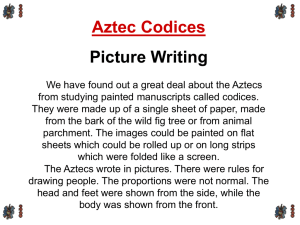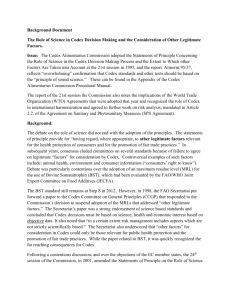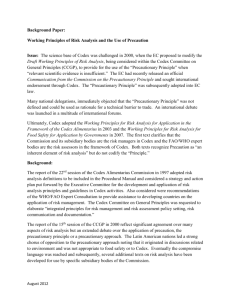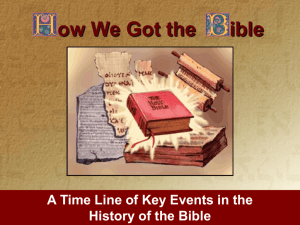C.L.A.S.S. Compass Life Adult Sunday School Pastor Pete January
advertisement
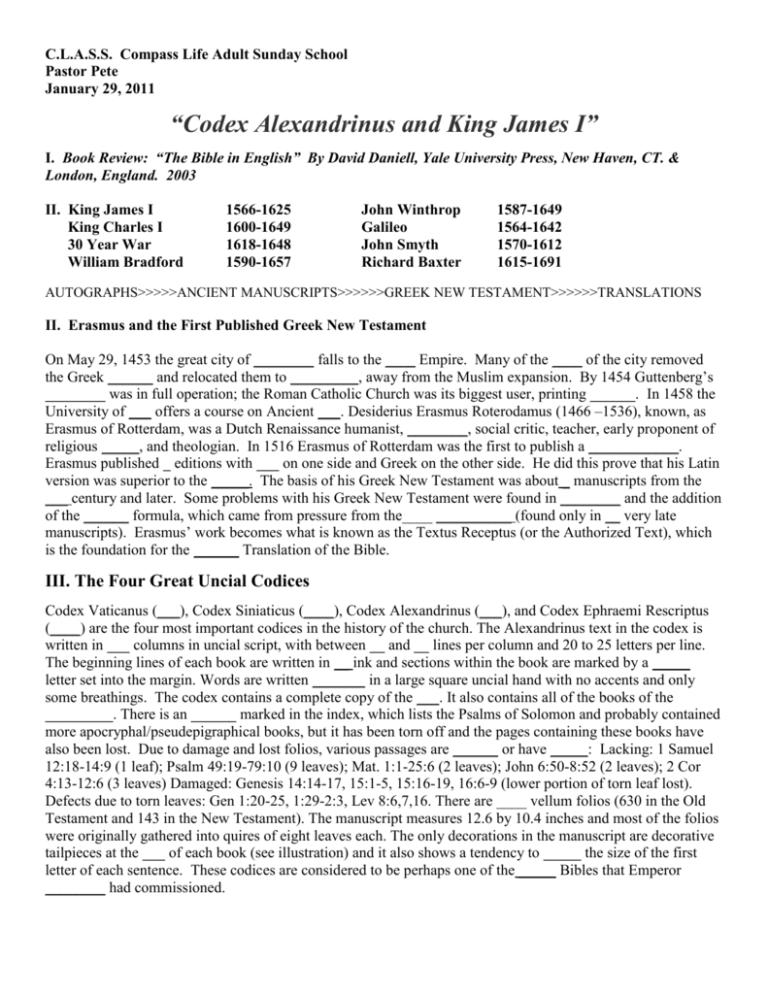
C.L.A.S.S. Compass Life Adult Sunday School Pastor Pete January 29, 2011 “Codex Alexandrinus and King James I” I. Book Review: “The Bible in English” By David Daniell, Yale University Press, New Haven, CT. & London, England. 2003 II. King James I King Charles I 30 Year War William Bradford 1566-1625 1600-1649 1618-1648 1590-1657 John Winthrop Galileo John Smyth Richard Baxter 1587-1649 1564-1642 1570-1612 1615-1691 AUTOGRAPHS>>>>>ANCIENT MANUSCRIPTS>>>>>>GREEK NEW TESTAMENT>>>>>>TRANSLATIONS II. Erasmus and the First Published Greek New Testament On May 29, 1453 the great city of ________ falls to the ____ Empire. Many of the ____ of the city removed the Greek ______ and relocated them to _________, away from the Muslim expansion. By 1454 Guttenberg’s ________ was in full operation; the Roman Catholic Church was its biggest user, printing ______. In 1458 the University of ___ offers a course on Ancient ___. Desiderius Erasmus Roterodamus (1466 –1536), known, as Erasmus of Rotterdam, was a Dutch Renaissance humanist, ________, social critic, teacher, early proponent of religious _____, and theologian. In 1516 Erasmus of Rotterdam was the first to publish a ____________. Erasmus published _ editions with ___ on one side and Greek on the other side. He did this prove that his Latin version was superior to the _____. The basis of his Greek New Testament was about _ manuscripts from the ___ century and later. Some problems with his Greek New Testament were found in ________ and the addition of the ______ formula, which came from pressure from the____ __________ (found only in __ very late manuscripts). Erasmus’ work becomes what is known as the Textus Receptus (or the Authorized Text), which is the foundation for the ______ Translation of the Bible. III. The Four Great Uncial Codices Codex Vaticanus (___), Codex Siniaticus (____), Codex Alexandrinus (___), and Codex Ephraemi Rescriptus (____) are the four most important codices in the history of the church. The Alexandrinus text in the codex is written in ___ columns in uncial script, with between __ and __ lines per column and 20 to 25 letters per line. The beginning lines of each book are written in __ ink and sections within the book are marked by a _____ letter set into the margin. Words are written _______ in a large square uncial hand with no accents and only some breathings. The codex contains a complete copy of the ___. It also contains all of the books of the _________. There is an ______ marked in the index, which lists the Psalms of Solomon and probably contained more apocryphal/pseudepigraphical books, but it has been torn off and the pages containing these books have also been lost. Due to damage and lost folios, various passages are ______ or have _____: Lacking: 1 Samuel 12:18-14:9 (1 leaf); Psalm 49:19-79:10 (9 leaves); Mat. 1:1-25:6 (2 leaves); John 6:50-8:52 (2 leaves); 2 Cor 4:13-12:6 (3 leaves) Damaged: Genesis 14:14-17, 15:1-5, 15:16-19, 16:6-9 (lower portion of torn leaf lost). Defects due to torn leaves: Gen 1:20-25, 1:29-2:3, Lev 8:6,7,16. There are ____ vellum folios (630 in the Old Testament and 143 in the New Testament). The manuscript measures 12.6 by 10.4 inches and most of the folios were originally gathered into quires of eight leaves each. The only decorations in the manuscript are decorative tailpieces at the ___ of each book (see illustration) and it also shows a tendency to _____ the size of the first letter of each sentence. These codices are considered to be perhaps one of the _____ Bibles that Emperor ________ had commissioned. IV. Codex Alexandrinus comes to England Kyrillos Loukaris was born in Candia, _____ on 13 November 1572, when Crete was part of the _____ maritime empire. In his youth he travelled through Europe, studying at ____ and Padua, and at ____ where he came under the influence of the reformed faith as represented by _______. Over time he developed strong ___ for Roman Catholicism. For six years Lucaris served as professor of the ______ academy in Vilinis (now in ______). Due to ____ oppression combined with the proselytization of the Orthodox faithful by _____ missionaries, there was a shortage of schools, which taught the _______ Faith and the ____ language. Roman Catholic schools were set up and Catholic churches were built ___ to Orthodox ones, and since Orthodox priests were in ________ something had to be done. His first act was to found a theological seminary in Mount _____, the Athoniada school. However his ultimate aim was to _____ the Orthodox Church along ________ lines, and to this end he sent many young _____ theologians to the universities of ________, the northern Netherlands and England. In 1629 he published his famous Confessio (______ doctrine), but as far as possible accommodated to the language and creeds of the _____ Churh. It appeared the same year in two Latin editions, four French, one German and one English, and in the Eastern Church started a ________, which culminated in 1672 with the convocation by Dositheos, Patriarch of _______, of the Synod of Jerusalem by which the Calvinistic doctrines were _______. Cyril was also particularly well disposed towards the Church of _______, and his correspondence with the Archbishop of Canterbury is extremely interesting. It was in his time that Kritopouloslater to become Patriarch of Alexandria (1636–1639) was sent to _______ to study. Both Lucaris and Kritopoulos were lovers of _____ and _______, and many of the items in the collections of books and these two Patriarchs acquired manuscripts that today adorn the Patriarchal Library. Lucaris was several times temporarily deposed and _______ at the instigation of both his ______ opponents and the Catholic French and Austrian ambassadors, while he was supported by the _______ Dutch and English ambassadors to the ________ capital. Meanwhile, in England King James tried ruling without convening ________. Without parliament’s approval there could be no ______, instead he received money from the ______ and _____. Then the ________ broke out and James ______ to support his Protestant son-in-law Frederick the King of ______. The people of England considered him a _____. James promised to help the German ________ if Parliament would agree to meet. James was secretly trying to marry his ___ to one of the ______ daughters, which was considered an abomination to the ______. The codex was brought to Constantinople in ____ by Lucar (first a patriarch of Alexandria, then later a patriarch of Constantinople). Lucar was involved in a complex struggle with the _____ government, the _____ Church, and his own subordinates. He was supported by ______ government and presented the codex to _____ in 1624, as a gratitude for his help. The codex was presented through the hands of Thomas Roe, the English ________ at the court of the ______. King James ___ before the manuscript started for England, and the offer was transferred to _____ in 1627. It became a part of the Royal Library, British Museum and since 1973 of the British Library. It was saved from the ____ at Ashburnam House on 23 October 1731, by the librarian, Bentley. Finally, when the _____ Sultan Murad IV was about to set out for the _____ War, the Patriarch was accused of a design to stir up the Cossacks, and to avoid trouble during his absence the Sultan had him ___ by the Janissaries on June 27, 1638 aboard a ship in the ______. His body was thrown into the ___, but it was recovered and buried at a distance from the capital by his friends, and only brought back to _________ after many years. V. Lessons from Codex Alexandrinus 1. The Bible___________________________ 2. The Bible___________________________ 3. The Bible___________________________ 2/5 “John Winthrop and Massachusetts Bay Colony”

